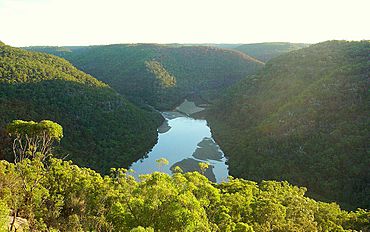Hornsby Plateau facts for kids
Quick facts for kids 
The river valleys of the plateau
|
|
The Hornsby Plateau is a large, flat area of land made of sandstone. It's located north of Sydney Harbour and rises about 200 metres high. This plateau is cut through by many deep, steep valleys, making it look like a puzzle of land pieces. It's actually part of a much bigger geological area called the Sydney Basin.
Contents
Where is the Hornsby Plateau?
You can find places like the North Shore and the Berowra Valley National Park on the Hornsby Plateau. The Colo River separates it from the Blue Mountains Plateau.
The plateau rises up from the Cumberland Plain in the south. This rise starts near Cattai and continues towards Botany Bay. The land here is usually between 200 and 220 metres high.
Valleys and Slopes
The plateau has many deep cuts called gullies, which are like small valleys. These gullies can be 80 to 100 metres deep where water flows. You'll also see very steep slopes that climb more than 100 metres.
The soil on the plateau is mostly a type called lithosols. This soil is not very fertile and is usually less than 50 centimetres deep.
How the Hornsby Plateau Formed
Millions of years ago, the Sydney area had freshwater sediments. These were rough layers of gravel up to 8 metres thick, covered by silt and sand. Over a long time, much of this sandy silt changed into a type of clay that contains silica.
Earth Movements
About 80 million years ago, at the end of a time period called the Tertiary period, big movements happened in the Earth's crust. These movements caused the land along the coast of eastern Australia to lift up by about 600 metres. This was due to the Tasman Sea forming and pulling apart.
These huge earth movements created the Blue Mountains and Hornsby Plateaux. The flatter land that was left behind became the Cumberland Plain.
Carving Valleys and Cliffs
After the plateau formed, freshwater streams began to flow over it. These streams slowly carved out a maze of V-shaped valleys. They cut deep into the Hawkesbury sandstone, which was soft enough for the water to wear away.
As the creeks cut deeper, they started to undercut the sandstone walls of the valleys. This caused large blocks of sandstone to break off and fall, creating the steep cliff lines you see today.
Rock Layers and Volcanoes
Because of its many hills and valleys, the Hornsby Plateau was slow to be developed by people. It has two main layers of rock:
- Hawkesbury sandstone: This layer is mostly sandstone but also has some shale.
- Ashfield Shale: This layer is on top of the Hawkesbury sandstone and helps support richer plant life.
You can also find a few places where volcanic rock pushed up through the plateau. These are called volcanic intrusions.



